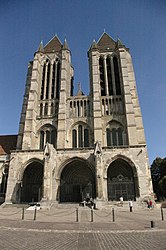Noyons
| Noyon | ||
|---|---|---|
| Commune | ||

The cathedral
|
||
|
||
| Coordinates: 49°34′54″N 2°59′59″E / 49.5817°N 2.9997°ECoordinates: 49°34′54″N 2°59′59″E / 49.5817°N 2.9997°E | ||
| Country | France | |
| Region | Hauts-de-France | |
| Department | Oise | |
| Arrondissement | Compiègne | |
| Canton | Noyon | |
| Intercommunality | Pays Noyonnais | |
| Government | ||
| • Mayor (2008–2014) | Patrick Deguise | |
| Area1 | 18 km2 (7 sq mi) | |
| Population (2012)2 | 13,658 | |
| • Density | 760/km2 (2,000/sq mi) | |
| Time zone | CET (UTC+1) | |
| • Summer (DST) | CEST (UTC+2) | |
| INSEE/Postal code | 60471 /60400 | |
| Elevation | 36–153 m (118–502 ft) (avg. 52 m or 171 ft) |
|
|
1 French Land Register data, which excludes lakes, ponds, glaciers > 1 km2 (0.386 sq mi or 247 acres) and river estuaries. 2Population without double counting: residents of multiple communes (e.g., students and military personnel) only counted once. |
||
1 French Land Register data, which excludes lakes, ponds, glaciers > 1 km2 (0.386 sq mi or 247 acres) and river estuaries.
Noyon (Latin: Noviomagus Veromanduorum, Noviomagus of the Veromandui) is a commune in the Oise department in northern France. It lies on the Oise Canal about 100 kilometers (60 mi) north of Paris.
The Gallo-Romans founded the town as Noviomagus (Celtic for "New Field" or "Market"). As several other cities shared the name, it was distinguished by specifying the people living in and around it. The town is mentioned in the Antonine Itinerary as being 27 Roman miles from Soissons and 34 Roman miles from Amiens, but d'Anville noted that the distance must be in error, Amiens being further and Soisson closer than indicated.
By the Middle Ages, the town's Latin name had mutated to Noviomum. The town was strongly fortified; some sections of the Roman walls still remained in late antiquity. This may explain why, around the year 531, bishop Medardus moved his seat from Vermand in the Vermandois to Noyon. (Another option was to move his seat to Saint-Quentin but the wine produced in Noyon was thought to be much better than that produced in Saint-Quentin. Other explanations are that Medardus was born near the town, at Salency, or that the place is nearer to Soissons, which was one of the royal capitals of the Merovingians.) The bishop of Noyon was also bishop of Tournai from the seventh century until Tournai was raised to a separate diocese 1146.
...
Wikipedia



